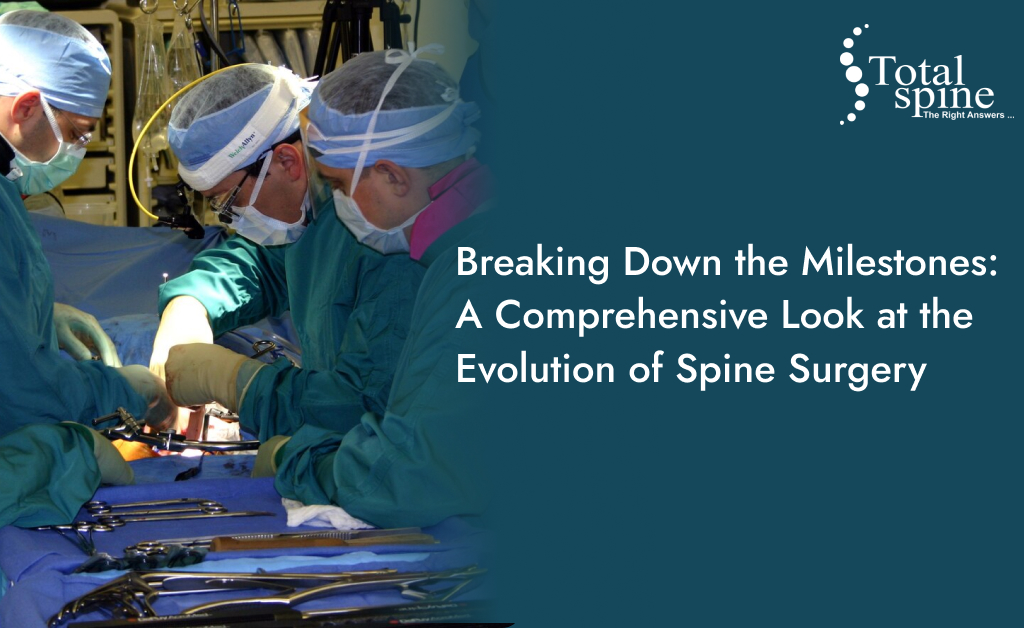No matter how positively we may think about spine surgery, the word has always induced fear in all of our minds. Myths and anxiety about the fear of going to a hospital for spine surgery or consulting a spine surgeon have always misconstrued everyone’s lives. The spine, which forms the framework of the body, is an essential component of every living thing’s existence. The fear of negativity has always risen when considering consulting a Spine Surgeon in Chennai or anywhere else in the world.
A spine surgeon’s work is a delicate and intricate art, one that has evolved over centuries. The history of spine surgery can be traced back to ancient civilizations, where early treatments involved crude methods such as traction, massage, and even trepanation.
The field of spine surgery has undergone significant change recently due to the development of minimally invasive methods. With smaller incisions, less blood loss, and faster recovery than traditional surgeries, these procedures provide a less invasive option.
With the development of cutting-edge technologies like robotics and 3D printing, spine surgery is still evolving from day to day. These developments open up new avenues for targeted, personalised treatments, ensuring a better future for people with spinal conditions.
The development of spine surgery throughout the years is a testament to the inventiveness and tenacity of medical professionals. The desire for relief from spine conditions has fueled innovation and advancement in the field from ancient civilizations to the present, and we can only speculate on the possibilities that lie ahead.
In the past, spinal operations were not as successful as they are now. Medical professionals now have a better understanding of how to perform minimally invasive procedures that result in less pain, quicker recoveries, and high-quality outcomes as a result of centuries of scientific advancement. In this article, we’ll examine the development of spine surgery over many years of experimentation.
Pioneers of Spine Surgery
Spine surgery was practised and researched in ancient orthopaedic societies. Spine problems weren’t unusual in ancient times. When people were involved in construction accidents or fell off horses, many of them sustained spinal fractures. People with spinal abnormalities frequently require back pain treatment.Although it’s likely that spine injury treatment dates back much further, the Egyptians are the first people to whom spinal disorders were ever mentioned.
The Edwin Smith Papyrus
The Edwin Smith papyrus, which dates back to the seventeenth century b.c., is a special treatise that includes the earliest descriptions of the signs and symptoms of spinal cord and spinal column injuries. The Smith papyrus’ enclosed secrets of diagnostic, prognostic, and therapeutic reasoning are reviewed in light of a recent “medically based translation.” The documented rationale for treating spinal injuries can still be regarded as the cutting-edge justification for contemporary clinical practice, despite the fact that patient demographics, diagnostic approaches, and therapeutic options have significantly changed over time. This demonstrates an early recognition of the link between spinal fractures and neurological issues.
Hippocrates, Father of Scientific Medicine
Hippocrates, the father of scientific medicine (5th–4th century B.C. ), left behind a priceless legacy of knowledge and methodology that permeates almost all fields of contemporary medicine. He studied different areas of medicine, but predominantly focused on the scientific methods of orthopaedics.
In actuality, some of the ideas and principles Curated in Hippocratic Treatises on Spine Fractures and Joints remain true today. The Hippocratic List of Spinal Problems includes fractures of the spinous processes, concussion, post-traumatic kyphosis, scoliosis, and tuberculous spondylitis. In order to reduce displaced vertebrae, Hippocrates created the Hippocratic board and the Hippocratic ladder.
Galen’s orthopaedics
Galen’s orthopaedics, particularly the way he describes the spine, can be seen to have a strong Hippocratic tradition influence. Galen developed a revolutionary model for the investigation of the human spine based on his observations obtained from the dissection and vivisection of animals. His investigation led to a precise description of the spinal cord and vertebral column.
Additionally, he discussed the distribution and direction of the nerves that emerge from the spine. He also dealt with injuries to the spine and spinal marrow as well as diseases that affect these structures, with a particular emphasis on spinal tuberculosis. Galen was the first medical professional to demonstrate the neurological effects of multiple levels of spinal cord transection.
First Successful Spine Surgeries
Spinal traction is a type of decompression therapy that dates back to 3500 B.C. It is the first spinal operation ever done. It involves the surgical removal of a portion of a vertebra to relieve pressure on the spinal cord or nerves. Paul of Aegina performed the first laminectomy around 650 A.D., and it was likely applied to treat spinal cord compression after a spinal injury.
Laser Spine Surgery
Dr. John C. Chiu pioneered the use of laser technology in spine surgery in 1986, performing the world’s first laser spine surgery on a patient with a herniated disc. The procedure involved inserting a tiny fibre-optic laser through a small incision in the patient’s back and using it to vaporise the damaged tissue causing the herniation.
Dr. Chiu went on to refine the technique, and laser spine surgery became a viable option for treating a range of spine conditions, including spinal stenosis and bulging discs. The history of laser spine surgery is a testament to the ingenuity and vision of medical professionals who have dedicated their careers to advancing the field of spine surgery and improving the lives of patients suffering from spine conditions.
History of Lumbar Disc Surgery
Mixter and Barr described the first surgical procedure to remove the herniated lumbar disc in 1934 through a laminectomy and durotomy, with later enhancement by Semmes, who described approaching the herniated disc through a hemilaminectomy and retraction of the dural sac. Laser technology in spine surgery was improved with just local anaesthesia, and other procedures for spinal decompression and pain relief were developed to work without opening the patient’s body. As time went by, surgical instruments were developed for this specific purpose, and visibility and accuracy increased.
First Fusionless Scoliosis Surgery in Chennai
The first fusion-less scoliosis surgery was conducted in Chennai in 2014, where the Spine Surgeon in Chennai and her team successfully completed a minimally invasive double curve correction using the innovative anterior scoliosis correction method without fusion. The 13-year-old girl was affected by adolescent idiopathic scoliosis, an abnormal side ward curvature of the spine. The patient underwent physiotherapy; her posture has improved, and her rib cage and spine are aligned and getting better.

Conclusion:
As we reflect on the history of spine surgeries, it becomes clear that the field has come a long way, with advancements in technology and surgical techniques offering patients more options and greater outcomes. Spine Surgeon in Chennai continue to push the boundaries of what is possible, offering patients innovative treatments and personalized care. Whether you are seeking treatment for a herniated disc, spinal stenosis, or another spine condition, finding the right spine surgeon is very essential. With their expertise and dedication, these skilled professionals can help you navigate the complex world of spine surgery and achieve the relief and mobility you deserve

